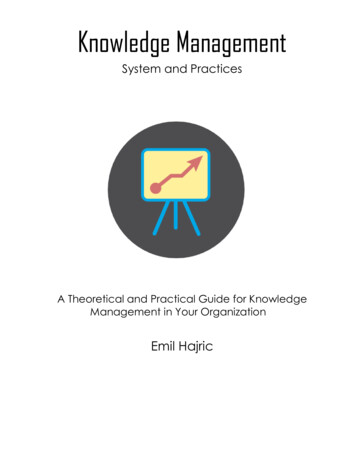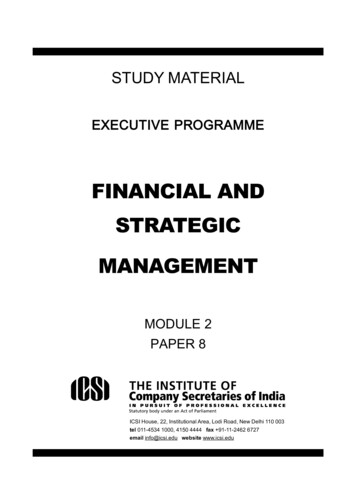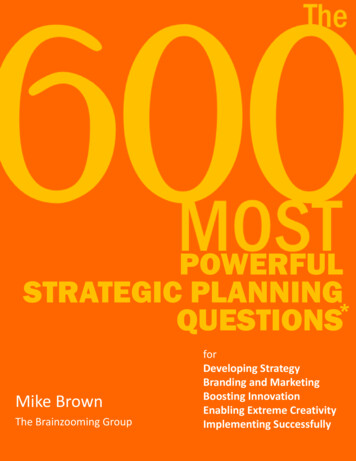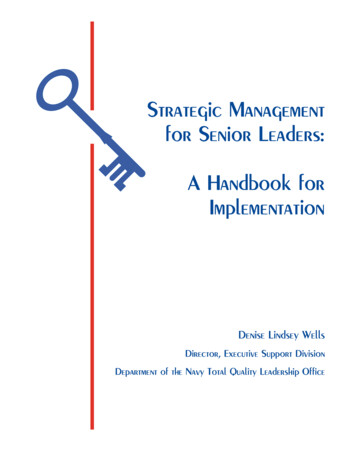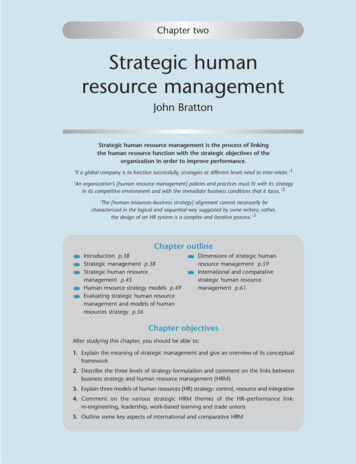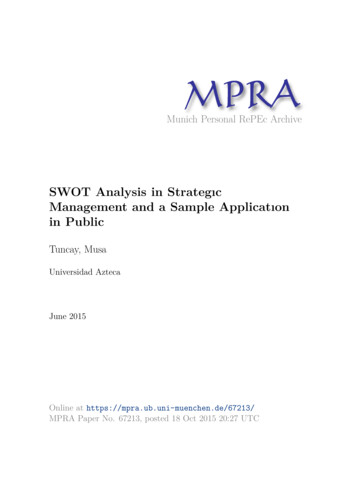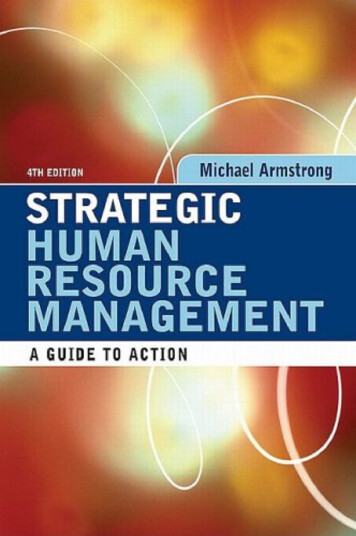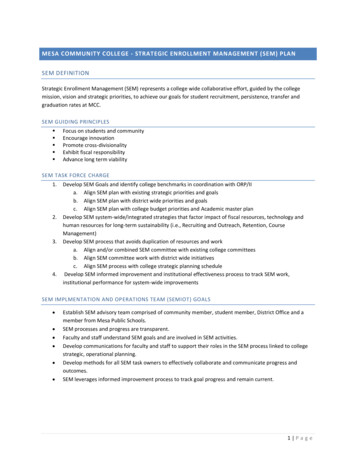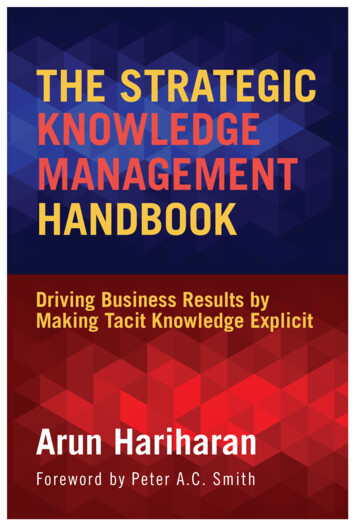
Transcription
THE STRATEGICKNOWLEDGEMANAGEMENTHANDBOOKDriving Business Results byMaking Tacit Knowledge ExplicitArun HariharanForeword by Peter A.C. Smith
The StrategicKnowledgeManagementHandbook
Also available from ASQ Quality Press:Continuous Permanent ImprovementArun HariharanProcess Improvement Simplified: A How-to-Book for Success in any OrganizationJames B. King, Francis G. King, and Michael W. R. DavisBusiness Process Improvement Toolbox, Second EditionBjørn AndersenThe Quality Toolbox, Second EditionNancy R. TagueThe ASQ Quality Improvement Pocket Guide: Basic History, Concepts,Tools, and RelationshipsGrace L. Duffy, editorPerformance Metrics: The Levers for Process ManagementDuke OkesThe Executive Guide to Innovation: Turning Good Ideas into Great ResultsJane Keathley, Peter Merrill, Tracy Owens, Ian Meggarrey, andKevin PoseyOutcomes, Performance, Structure (OPS): Three Keys toOrganizational ExcellenceMichael E. Gallery and Stephen C. CareyThe ASQ Pocket Guide for the Certified Six Sigma Black BeltT.M. KubiakThe ASQ Pocket Guide to Root Cause AnalysisBjørn Andersen and Tom Natland FagerhaugThe Quality Improvement Handbook, Second EditionASQ Quality Management Division and John E. Bauer, Grace L. Duffy,Russell T. Westcott, editorsProcess Improvement Using Six Sigma: A DMAIC GuideRama ShankarThe Certified Manager of Quality/Organizational Excellence Handbook,Fourth EditionRussell T. Westcott, editorTo request a complimentary catalog of ASQ Quality Press publications, call800-248-1946, or visit our Web site at http://qualitypress.asq.org.
The StrategicKnowledgeManagementHandbookDriving Business Results byMaking Tacit Knowledge ExplicitArun Hariharan(Foreword by Peter A.C. Smith)ASQ Quality PressMilwaukee, Wisconsin
American Society for Quality, Quality Press, Milwaukee, WI 53203 2015 by ASQ.All rights reserved. Published 2015.Printed in the United States of �� 1Library of Congress Cataloging-in-Publication DataHariharan, Arun.The strategic knowledge management handbook: driving business results bymaking tacit knowledge explicit/Arun Hariharan; foreword by Peter A.C. Smith.pages cmIncludes bibliographical references.ISBN 978-0-87389-914-7 (hardcover: alk. paper)1. Knowledge management. 2. Strategic planning. 3. Management. I. Title.HD30.2.H37186 2015658.4’038—dc232015016074No part of this book may be reproduced in any form or by any means, electronic,mechanical, photocopying, recording, or otherwise, without the prior writtenpermission of the publisher.Publisher: Lynelle KorteAcquisitions Editor: Matt T. MeinholzManaging Editor: Paul Daniel O’MaraProduction Administrator: Randall BensonASQ Mission: The American Society for Quality advances individual,organizational, and community excellence worldwide through learning, qualityimprovement, and knowledge exchange.Attention Bookstores, Wholesalers, Schools, and Corporations: ASQ QualityPress books, video, audio, and software are available at quantity discounts withbulk purchases for business, educa tional, or instructional use. For information,please contact ASQ Quality Press at 800-248-1946, or write to ASQ Quality Press,P.O. Box 3005, Milwaukee, WI 53201-3005.To place orders or to request ASQ membership information, call 800-248-1946.Visit our Web site at www.asq.org/quality-press.Printed on acid-free paper
DedicationThis book is dedicated to my parents Lakshmi and N.A. Hariharan,my wife Bhuvana, and our children Srihari and Lakshmi.
ContentsList of Figures and Tables. . . . . . . . . . . . . . . . . . . . . . . . . . . . . . . . . . . . . . . . .xiForeword. . . . . . . . . . . . . . . . . . . . . . . . . . . . . . . . . . . . . . . . . . . . . . . . . . . . . . xiiiPreface. . . . . . . . . . . . . . . . . . . . . . . . . . . . . . . . . . . . . . . . . . . . . . . . . . . . . . . . xvChapter 1Knowledge Management is Fun. . . . . . . . . . . . . . . . . . . . . .Introduction. . . . . . . . . . . . . . . . . . . . . . . . . . . . . . . . . . . . .Data, Information, Knowledge, Wisdom. . . . . . . . . . . . .Business Example. . . . . . . . . . . . . . . . . . . . . . . . . . . . . . . .Application and Results. . . . . . . . . . . . . . . . . . . . . . . . . . .Chapter 2 Knowledge Management: Strategy,Not Technology. . . . . . . . . . . . . . . . . . . . . . . . . . . . . . . . . . . .If Only We Knew What We Know . . . . . . . . . . . . . . . . . .What Is Knowledge Management? . . . . . . . . . . . . . . . . .Business Strategy: Both the Starting Pointand the Objective. . . . . . . . . . . . . . . . . . . . . . . . . . . . . . .Strategic Steps in Knowledge Management. . . . . . . . . .What it Takes to Make KnowledgeManagement Work. . . . . . . . . . . . . . . . . . . . . . . . . . . . .Motivating Knowledge Performance. . . . . . . . . . . . . . . .Creating a Culture of Knowledge Sharing andReuse Rather Than Knowledge Hoarding . . . . . . . . .Measuring the Results of Knowledge Management. . .Conclusion. . . . . . . . . . . . . . . . . . . . . . . . . . . . . . . . . . . . . .vii11467991011131619222326
viii ContentsChapter 3 Knowledge Management Processes: The BestPractice Funnel. . . . . . . . . . . . . . . . . . . . . . . . . . . . . . . . . . . . .Results of Robust KM Processes at BA Services. . . . . . .KM Processes at BA Services. . . . . . . . . . . . . . . . . . . . . . .Scenario 1: Knowledge Sharing . . . . . . . . . . . . . . . . . . . .The Knowledge Sharing Process. . . . . . . . . . . . . . . . . . .The Knowledge Portal. . . . . . . . . . . . . . . . . . . . . . . . . . . .Other Knowledge Categories and Processes forExternal Knowledge. . . . . . . . . . . . . . . . . . . . . . . . . . . .Knowledge Submission and Approval Process. . . . . . .Knowledge Sharing Culture and Motivation. . . . . . . . .Results of the Knowledge Sharing Process. . . . . . . . . . .Scenario 2: Knowledge Replication . . . . . . . . . . . . . . . . .The Knowledge Replication Process . . . . . . . . . . . . . . . .Results of the Knowledge Replication Process. . . . . . . .Process for Capturing New Knowledge AddedDuring Replication. . . . . . . . . . . . . . . . . . . . . . . . . . . . .Knowledge Replication Culture and Motivation. . . . . .Incorporating Knowledge Submissions IntoStandard Business Processes. . . . . . . . . . . . . . . . . . . . .The Four Pillars of Knowledge Management. . . . . . . . .Sharing Experiences with Other Organizations. . . . . . .Relevance to Your Company. . . . . . . . . . . . . . . . . . . . . . .Conclusion. . . . . . . . . . . . . . . . . . . . . . . . . . . . . . . . . . . . . .Chapter 4360-Degree Knowledge Management. . . . . . . . . . . . . . . . .Introduction. . . . . . . . . . . . . . . . . . . . . . . . . . . . . . . . . . . . .Communities of Experts and KnowledgeChampions. . . . . . . . . . . . . . . . . . . . . . . . . . . . . . . . . . . .The First Three How Questions HaveBeen Answered. . . . . . . . . . . . . . . . . . . . . . . . . . . . . . . .The 360-Degree Knowledge Management Model. . . . .The Six Dimensions of 360-Degree KnowledgeManagement . . . . . . . . . . . . . . . . . . . . . . . . . . . . . . . . . .Balancing Relevance and Content Quality withCulture Building. . . . . . . . . . . . . . . . . . . . . . . . . . . . . . .Establish Standard KM Processes. . . . . . . . . . . . . . . . . . .Role of Technology in 360-Degree KM. . . . . . . . . . . . . . .Conclusion. . . . . . . . . . . . . . . . . . . . . . . . . . . . . . . . . . . . . 85861626264
ContentsChapter 5Chapter 6ixIdeas, Innovation, and Knowledge Management. . . . . . .A Shaky Start. . . . . . . . . . . . . . . . . . . . . . . . . . . . . . . . . . . .A Process for Ideas and Innovation—At Two Levels. . .Innovation Process for Large Business Ideas . . . . . . . . .Continuous Process for Innovation . . . . . . . . . . . . . . . . .Will Ideas Dry Up?. . . . . . . . . . . . . . . . . . . . . . . . . . . . . . .Your Company Culture Can Either Encourage orKill Innovation. . . . . . . . . . . . . . . . . . . . . . . . . . . . . . . . .The Impact on People and Morale. . . . . . . . . . . . . . . . . .Conclusion. . . . . . . . . . . . . . . . . . . . . . . . . . . . . . . . . . . . . .656666686970Critical Success Factors for Knowledge Management. . .Introduction. . . . . . . . . . . . . . . . . . . . . . . . . . . . . . . . . . . . .17 Challenges—How to Overcome Them andGet Real Business Results From KM . . . . . . . . . . . . . . . .Conclusion. . . . . . . . . . . . . . . . . . . . . . . . . . . . . . . . . . . . . .7373Chapter 7 The Seven Enablers to KM: Knowledge Managementat BA Services—A Case Study. . . . . . . . . . . . . . . . . . . . . . .What Knowledge Management Means tothe Company. . . . . . . . . . . . . . . . . . . . . . . . . . . . . . . . . .Why the Company Embarked on a FormalKM Program . . . . . . . . . . . . . . . . . . . . . . . . . . . . . . . . . .Key Enablers of KM . . . . . . . . . . . . . . . . . . . . . . . . . . . . . .Measuring the Impact or Results of KM. . . . . . . . . . . . .Critical Factors Responsible for theInstitutionalization of KM. . . . . . . . . . . . . . . . . . . . . . .Chapter 8 How to Build a Great KnowledgeManagement Portal. . . . . . . . . . . . . . . . . . . . . . . . . . . . . . . . .Introduction. . . . . . . . . . . . . . . . . . . . . . . . . . . . . . . . . . . . .Case Examples. . . . . . . . . . . . . . . . . . . . . . . . . . . . . . . . . . .Who is the Customer of the KM Portal? . . . . . . . . . . . . .Keep it Simple for the User. . . . . . . . . . . . . . . . . . . . . . . .How Your Portal Can Enable You to Implementthe 360-Degree Knowledge Management Model. . . .The Role of the KM Portal in Enabling360-Degree KM . . . . . . . . . . . . . . . . . . . . . . . . . . . . . . . .How KM Really Works. . . . . . . . . . . . . . . . . . . . . . . . . . . .Indicative KM Portal Functional Specifications. . . . . . .A Note for Technology Vendors and KMPractitioners. . . . . . . . . . . . . . . . . . . . . . . . . . . . . . . . . . .717272738183838384878789899092929393949698
xContentsChapter 9 360-Degree Knowledge Management and theBalanced Scorecard. . . . . . . . . . . . . . . . . . . . . . . . . . . . . . . . .The 360-Degree Knowledge managementModel—Recap. . . . . . . . . . . . . . . . . . . . . . . . . . . . . . . . .How the Balanced Scorecard Helps360-Degree KM . . . . . . . . . . . . . . . . . . . . . . . . . . . . . . . .How 360-Degree KM Helps your BalancedScorecard Initiative. . . . . . . . . . . . . . . . . . . . . . . . . . . . .Synergy not Limited to the Learning and Growth. . . . .Do Not Lose Focus. . . . . . . . . . . . . . . . . . . . . . . . . . . . . . .Conclusion. . . . . . . . . . . . . . . . . . . . . . . . . . . . . . . . . . . . . .9999100101101102102Chapter 10 Knowledge Management and Quality. . . . . . . . . . . . . . . . 103How KM Can Help Quality. . . . . . . . . . . . . . . . . . . . . . . . 104How Quality Can Help KM. . . . . . . . . . . . . . . . . . . . . . . . 104Chapter 11 A Word to the CKO. . . . . . . . . . . . . . . . . . . . . . . . . . . . . . . . . 105Chapter 12 A Word to Business Leaders. . . . . . . . . . . . . . . . . . . . . . . . . 109Chapter 13 Knowledge Management in Government. . . . . . . . . . . . . 113The Opportunity. . . . . . . . . . . . . . . . . . . . . . . . . . . . . . . . . 114The Challenges and Solutions. . . . . . . . . . . . . . . . . . . . . . 116Chapter 14 Summing It All Up: The Strategic KnowledgeManagement Franework. . . . . . . . . . . . . . . . . . . . . . . . . . . . 123Differences Between KM as a Strategy and aTechnology Only Approach. . . . . . . . . . . . . . . . . . . . . . 123The Strategic Knowledge Management Framework. . . 124Chapter 15 A Call to Action. . . . . . . . . . . . . . . . . . . . . . . . . . . . . . . . . . . . 135Conclusion. . . . . . . . . . . . . . . . . . . . . . . . . . . . . . . . . . . . . . 138References. . . . . . . . . . . . . . . . . . . . . . . . . . . . . . . . . . . . . . . . . . . . . . . . . . . . . 139About the Author. . . . . . . . . . . . . . . . . . . . . . . . . . . . . . . . . . . . . . . . . . . . . . . 141Index. . . . . . . . . . . . . . . . . . . . . . . . . . . . . . . . . . . . . . . . . . . . . . . . . . . . . . . . . 143
List of Figures and TablesFigure 1Types of knowledge . . . . . . . . . . . . . . . . . . . . . . . . . . . . . . . . . . . . . . . . . . . . . . . . xviiiFigure 2The role of knowledge management in each type of knowledge . . . . . . . . . . xixFigure 3Data, information, knowledge, and wisdom—application and results. . . . .Figure 4Sample strategy matrix. . . . . . . . . . . . . . . . . . . . . . . . . . . . . . . . . . . . . . . . . . . . . . 12Figure 5Strategic knowledge map. . . . . . . . . . . . . . . . . . . . . . . . . . . . . . . . . . . . . . . . . . . . 13Table 1Sample business excellence model. . . . . . . . . . . . . . . . . . . . . . . . . . . . . . . . . . . . 21Figure 6Sample performance dashboard. . . . . . . . . . . . . . . . . . . . . . . . . . . . . . . . . . . . . . 29Figure 7Knowledge sharing process. . . . . . . . . . . . . . . . . . . . . . . . . . . . . . . . . . . . . . . . . . 32Figure 8Best practice funnel. . . . . . . . . . . . . . . . . . . . . . . . . . . . . . . . . . . . . . . . . . . . . . . . . 33Figure 9Sample knowledge sharing format . . . . . . . . . . . . . . . . . . . . . . . . . . . . . . . . . . . 35Table 2How the Knowledge Dollar (K ) scheme works. . . . . . . . . . . . . . . . . . . . . . . . 37Figure 10Knowledge replication process. . . . . . . . . . . . . . . . . . . . . . . . . . . . . . . . . . . . . . . 40Figure 11Sample knowledge replication format. . . . . . . . . . . . . . . . . . . . . . . . . . . . . . . . . 42Table 3Sample business results through KM. . . . . . . . . . . . . . . . . . . . . . . . . . . . . . . . . . 43Figure 12The four pillars of knowledge management. . . . . . . . . . . . . . . . . . . . . . . . . . . . 51Figure 13The 360-degree knowledge management model. . . . . . . . . . . . . . . . . . . . . . . . 59Table 4Sample summary report of ideas generated and implemented. . . . . . . . . . . . 67Table 5Sample detailed list of implemented ideas. . . . . . . . . . . . . . . . . . . . . . . . . . . . . 68Table 6Behavioral challenges to KM. . . . . . . . . . . . . . . . . . . . . . . . . . . . . . . . . . . . . . . . . 77Table 7Sample measures of knowledge management. . . . . . . . . . . . . . . . . . . . . . . . . . 110Figure 14Strategic knowledge management framework. . . . . . . . . . . . . . . . . . . . . . . . . . 125Table 8Strategic knowledge management framework elementsand sub-elements . . . . . . . . . . . . . . . . . . . . . . . . . . . . . . . . . . . . . . . . . . . . . . . . . . 126Table 9KM do’s and don’t’s. . . . . . . . . . . . . . . . . . . . . . . . . . . . . . . . . . . . . . . . . . . . . . . . 136Figure 15Strategic knowledge management program implementation roadmap. . . . . 137xi5
ForewordArun Hariharan, the author of this book, maintains that it has beenwritten principally for CEOs and senior management to help themunderstand how they can actually implement a strategic knowledgemanagement (KM) program in their business and derive real demonstrablebusiness results from such programs that will help them achieve theirbusiness objectives. Hariharan believes that manufacturing, service,education, not-for-profit, government, and other types of organizationswill benefit from the book. The challenge is to provide practical insightsacross a broad range of organizations that senior executives will actuallyappreciate and put into practice—a tall order indeed! Nonetheless,Hariharan demonstrates that he has the breadth of experience, and thepractical know-how, to reach these goals admirably.One of the ways Hariharan achieves these objectives is by usingillustrative stories of how KM has been leveraged to achieve strategicbusiness objectives in various organizations, and by providing practicaltools such as the 360-degree knowledge management model and examplesof its use. Hariharan emphasizes the significance of ideas and innovationas critical components of a successful KM initiative. In particular, thisauthor familiarizes the reader with the very important topic of how tocreate a culture of knowledge sharing and how to motivate employeestoward knowledge performance. Hariharan examines typical challengesthat executives and their organizations must successfully overcome toimplement KM, and via case studies he highlights the seven enablers ofKM (the critical success factors) that are essential to achieving significantbusiness results. Finally, he describes his ‘call to action’ to get the reader’scompany started on its KM journey, including a step-by-step roadmap toimplement everything that is written in his book.xiii
xiv ForewordThis practical book will help CEOs and senior managementunderstand how they can implement a strategic KM program in theirbusiness and derive real demonstrable business results.Peter A.C. SmithPeter A.C. Smith is the Publisher and Managing Editor of the Journal ofKnowledge Management Practice (world KM ranking #7). He is Presidentand CEO, The Leadership Alliance Inc. and Director of Strategy, Center forDynamic Leadership Models in Global Business. He is the co-author of the bookDynamic Leadership Models for Global Business: Enhancing DigitallyConnected Environments.
PrefaceOrganizational knowledge is your strategic asset.Wake up and profit from it.When I visited one of the world’s most advanced car manufacturingplants at Toyota City, Japan, one of the many things about theircar manufacturing process that struck me as remarkable was the factthat from start to finish, from molding the steel sheet into the car bodyto fitting various parts, almost all the work was done by machines androbots. This is, of course, true of nearly every car manufacturer today.Take another story. When I opened my first bank account nearly thirtyyears ago, I had to fill out an application form, attach some documents,and submit it to the bank. The bank employee did a whole lot of work,all on paper (this bank had no computers in those days). Some dayslater (weeks, if I remember right), I had my bank account. Recently, mydaughter Lakshmi needed a new bank account. Today most of the work inthe account-opening process, once done manually, is done by computers.Lakshmi had her new bank account almost instantly.In both examples above, work that used to be done manually bypeople has been ‘taught’ to machines. In other words, the knowledge thatwas inside people’s heads has been transferred to the machines.Some time ago, I worked with a large global consulting firm thathad more than 70,000 people and operated in more than 140 countries.I was part of a team of consultants assigned to a large petrochemicalscompany. Between the four of us, we had a fair amount of knowledgeand experience in the kind of work we needed to do for this client.However, there were occasions when the team found that we did nothave the knowledge required for a specific component of the project. Thiswas never a problem, because we had online access to the firm’s global‘knowledge base,’ which stores documented knowledge, case studies, andproject files from all work done by the firm worldwide. In almost everysuch situation, we were able to find documented knowledge relating toxv
xvi Prefacea similar project done by other consultants in the firm for another client,which we were able to quickly learn and use in our project.On rare occasions, we would be confronted by a particularly difficultproblem or one requiring highly specialized knowledge and experienceheld by only a few experts in the firm. In such cases, we would turn to thefirm’s global knowledge base, not for documented knowledge but to findout who and where in the world these experts were. In a matter of minutesor a few hours (allowing for time zones across 140 countries), we wouldhave access to an expert who could advise us and our client.In all three examples above, it was the knowledge in people’s headsthat was captured and deployed by the organization. In other words, theyhave converted individual knowledge into ‘organizational knowledge.’ Ifyou think about it, you will notice that there are three ways in which thisorganizational knowledge is deployed:1. The most obvious and foolproof way of converting individualknowledge into organizational knowledge and deploying it is to‘teach’ it to machines (as in the example of the car manufacturerand the bank).2. For work done by people and not machines, knowledge from pastexperience (of the firm, or even from outside) becomes permanentorganizational knowledge that can be reused by its people whenthey need it—if it’s properly documented and stored with easysearch-and-retrieval capability. This type of knowledge (thatcan be documented) is called explicit knowledge by knowledgemanagement (KM) experts.3. Obviously, not all knowledge can be documented. Someknowledge will always flow from an expert’s intuition and muchof that comes from years of experience in the field. KM expertscall this tacit knowledge. In large multi-location organizations suchas the global consulting firm that I talked about, knowing whoor where the expert is for the particular type of knowledge youneed, and being able to find them quickly, can be a challenge. KMquickly identifies and facilitates access to the expert(s).The car manufacturer continues to make cars, and the bank continuesto add new customer accounts. These processes continue to work evenwhen individual employees who knew these jobs leave the organization.This is because the organization has internalized the knowledge byteaching a good part of it to machines. Advances in technology make itpossible to teach most repetitive jobs and increasingly complex jobs tomachines.
PrefacexviiThe consulting firm, too, has internalized individual knowledge tothe maximum extent possible. However, unlike fitting seats to a car oropening a new bank account, in this case the work is not a repetitive task.No two consulting assignments are exactly alike, and a certain amount ofintelligence must be applied at the time the final ‘product’ is delivered tothe client. Such jobs cannot be completely taught to machines. However,our experience in the consulting firm was that a considerable amountof ‘reinvention of the wheel’ was avoided and significant time and costwere saved—for the firm as well as for clients—by the firm’s practice ofsystematically documenting and making relevant knowledge availablewhere required.The companies in these examples are doing knowledge management(KM) in one form or another. Does this mean that KM is a replacement forpeople and their skills? In my experience, no. What KM does is to makeit possible to teach repetitive tasks to machines, and prevent or minimizethe amount of relevant knowledge that walks out when individuals leavethe firm. As we saw in the consulting firm, KM cannot be a completereplacement for people’s skills, experience, expertise, and intuition.However, KM can help the firm and individuals to deploy availableknowledge more effectively and efficiently.Moreover, most new knowledge evolves from existing knowledge.For example, the horse-cart could be invented because knowledge aboutthe wheel already existed, and the automobile could be invented becausethe horse-cart already existed.However, new knowledge usually does not evolve on its own. Thisrequires people. If the existing knowledge is available in an organizedfashion (as in the example of the consulting firm, or most scientificknowledge), it can facilitate evolution of new knowledge. Thus, in thedomain of innovation and inventions, KM cannot replace people, but canbe a useful enabler or aid.See Figure 1 for types of knowledge and Figure 2 for the role ofknowledge management in each type of knowledge relevant to yourbusiness.The primary purpose of this book is to enable you to implement astrategic KM program in your business and derive business results fromit. The contents of this book are relevant to any business—manufacturingor service, and also in education, not-for-profit, government, and othertypes of organizations.This book is written for business leaders and executives. It isparticularly addressed to CEOs and senior management to help themunderstand how they can use KM as a strategic tool to achieve theirbusiness objectives. For KM professionals, the objective of this book is tohelp them to implement KM with real business results.
Figure 1 Types of knowledge.Repetitive(can be automated ortaught to machines)ExplicitNot repetitive (butcan be documented &reused by others)Knowledge relevantto your businessNew knowledgecreation (usually evolvesfrom existing knowledge)Tacit(expert, intuition)xviii Preface
Role of KMDocumentation of completedprojects, best practices, lessonslearned, process-steps, FAQs,competitor information, etc.Role of KMProviding an organized view ofexisting knowledge can facilitatefurther innovation or creation ofnew knowledgeNew knowledgecreation (usually evolvesfrom existing knowledge)Tacit(expert, intuition)Role of KMKnowledge mapping or yellowpages of “who knows what”; quickidentification of and access toexperts for specialized knowledge;collaboration with experts,communities of practiceNot repetitive (butcan be documented &reused by others)Figure 2 The role of knowledge management in each type of knowledge.Role of KMDocumentation of standardizedprocess/process map or functionalspecifications, which can form thebasis for automationRepetitive(can be automated ortaught to machines)ExplicitKnowledge relevantto your businessPrefacexix
xxPrefaceWe will start by looking at an interesting non-business story of abunch of friends called the Fitness Freaks. Reading this enjoyable storywill give you a good idea about what KM is and what it can do for yourbusiness, and how. We will then go on to see how some companies havesuccessfully made KM an enabler of their strategic business objectives,rather than an esoteric intellectual concept. We will look at how to create astrategic knowledge map for your business that flows from your strategicbusiness objectives. We will then see what it takes to make KM work inyour organization, how KM enables you to achieve real business benefits,and how to measure the results. Next, we will talk about how to motivateyour employees toward knowledge performance, and how to create a cultureof knowledge sharing and replication. After this, we will look at how youcan put simple but effective processes in place to capture as well as applyknowledge that is relevant to your business.Next we will see the 360-degree knowledge management model,and examples of companies that have implemented this model. This isfollowed by a discussion of the role of ideas and innovation as importantcomponents of KM.The chapter on the 360-degree knowledge management model andthe chapter on ideas appeared in my earlier book, Continuous PermanentImprovement (Hariharan, ASQ Quality Press 2014). The context in thatbook was that KM and innovation are important components of businessexcellence. I felt that my book on KM would be incomplete if I didn’ttalk about the 360-degree KM model and about ideas. Hence these twochapters are also included in this book.We will then take a look at typical challenges and how to overcomethem in order for KM to give you significant business results—in otherwords, the critical success factors for KM. After this, we will look at sevenenablers of KM through the case example of a large company. Next, wewill look at how to build a great KM portal, and suggested functionalspecifications for your KM portal. The next two chapters talk about howyou can synergize your KM program with the balanced scorecard andwith your quality program. This is followed by two chapters that sharetips for CKOs and CEOs, respectively, on how to achieve maximumbusiness results from KM.The final chapter is a call to action that will help you get yourcompany started on its KM journey. It provides a step-by-step roadmapto implement everything that is written in this book.Now a word about what this book is not about. The book is primarilyintended to help businesses (or other organizations) implement a strategicKM program that contributes to achieving strategic business objectives.It is not a book on knowledge or information theory from an academicstandpoint, although it does touch briefly upon the interesting and muchwritten-about distinctions between data, information, knowledge, andwisdom (DIKW). The purpose of this book is to help businesses derive real
Prefacexxiresults through the application of the KM strategies, methods, processes,and lessons learned from the various real examples of KM application inbusiness as described in the book. For the purpose of deriving businessresults from KM, companies that I worked with did not find it necessaryto go into the finer distinctions between data, information, knowledge,and wisdom. For our purpose in this book, we use the term knowledge ina broad sense to include any information or knowledge relevant to yourbusiness. For academically oriented readers who might be interested inthe theory of DIKW, there is plenty of published literature on the subject.Given the universal or broad scope of the book and because of itsstrategic and multi-disciplinary audience (including CEOs and seniorexecutives from diverse indus
The ASQ Pocket Guide for the Certified Six Sigma Black Belt T.M. Kubiak The ASQ Pocket Guide to Root Cause Analysis Bjørn Andersen and Tom Natland Fagerhaug The Quality Improvement Handbook, Second Edition ASQ Quality Management Division and Jo


